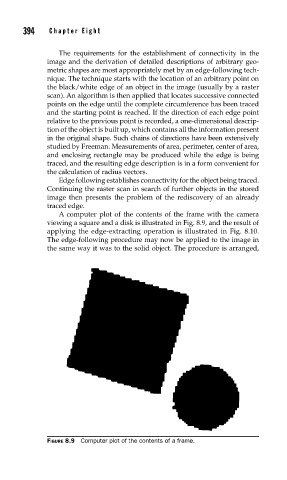Page 440 - Sensors and Control Systems in Manufacturing
P. 440
394
Cha p te r
Ei g h t
The requirements for the establishment of connectivity in the
image and the derivation of detailed descriptions of arbitrary geo-
metric shapes are most appropriately met by an edge-following tech-
nique. The technique starts with the location of an arbitrary point on
the black/white edge of an object in the image (usually by a raster
scan). An algorithm is then applied that locates successive connected
points on the edge until the complete circumference has been traced
and the starting point is reached. If the direction of each edge point
relative to the previous point is recorded, a one-dimensional descrip-
tion of the object is built up, which contains all the information present
in the original shape. Such chains of directions have been extensively
studied by Freeman. Measurements of area, perimeter, center of area,
and enclosing rectangle may be produced while the edge is being
traced, and the resulting edge description is in a form convenient for
the calculation of radius vectors.
Edge following establishes connectivity for the object being traced.
Continuing the raster scan in search of further objects in the stored
image then presents the problem of the rediscovery of an already
traced edge.
A computer plot of the contents of the frame with the camera
viewing a square and a disk is illustrated in Fig. 8.9, and the result of
applying the edge-extracting operation is illustrated in Fig. 8.10.
The edge-following procedure may now be applied to the image in
the same way it was to the solid object. The procedure is arranged,
FIGURE 8.9 Computer plot of the contents of a frame.

